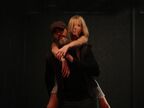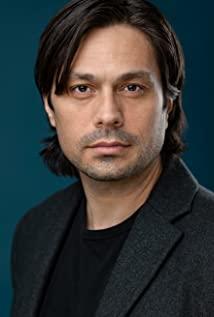The film uses a minimalist narrative and a distinctive audio-visual style to tell a story about salvation. The protagonist of the film, Joe, is a contract killer. He is taciturn, neat and brutal. At the same time, he was deeply trapped in the trauma of witnessing domestic violence in his childhood and witnessing various deaths when he was a soldier. A voice, a face, and anything related to trauma would immediately plunge him into that helpless, terrifying memory. In this way, Joe wanders between the extremes of violence and vulnerability. In the film, he was hired to rescue a girl who was sold as a prostitute, Nina, but was accidentally involved in a series of corrupt and ugly sex crimes.
In Joe's unstable mental state, on the one hand, he was extremely violent when he was hired, and on the other, he was extremely vulnerable when he was deeply traumatized. In addition, Joe often fell into a daze, as if entering an emotional vacuum zone, without any waves. Only when he gets along with his mother or Nina, we can see his rare softness and warmth.
After understanding the character and state of the characters, we have a breakthrough to interpret the sound design. The sound design of the film closely revolves around Joe's emotional state, using many subjective designs to immerse the audience in Joe's restless mood. Therefore, the overall sound design presents a strong contrast between dynamics and statics, which is what we often call "big dynamics". Whether it's sound effects or music, it often comes suddenly and stops abruptly, just like Joe's painful memory. We feel Joe's complex and extreme emotions and states from it.
There are several more obvious places: Joe, who has accepted the task, is walking down the stairs. At this time, the sound in the stairwell is as dull as a vacuum. Then, when he walked down the stairs completely and kicked the door abruptly, the noisy city sounds instantly poured into the soundtrack, forming a strong contrast between movement and static. It is worth noting that when Joe went upstairs to accept the task, the outside voice could be heard in this stairwell. Here, the creator deliberately pulled the outside sound away because in the previous scene, Joe was sinking in his own thoughts, so the dull voice here allows the audience to enter Joe’s "vacuum" emotions. When the sound of the city came in, the audience returned to reality from his thoughts together with Joe.
In the middle of the film, after a fierce life and death struggle, Joe escapes from the scene of the incident. In this passage, the strong impulse sound brings the tense atmosphere to a climax, and then a pulsating electronic music and a burst of police sirens bring us into unknown anxiety. Suddenly, all sounds stopped abruptly as the fire ladder landed. In the next picture, we see Joe pulling his teeth calmly.
In another more obvious design, we can notice that the mother's home is particularly quiet, while the streets of New York are extremely noisy. The switching of the two scenes creates a strong contrast throughout the film. Paul Davies, the sound designer of the film, said in an interview that he deliberately highlighted the contrast between the two, not only making the mother's house particularly quiet, but also amplifying the noise on the streets of New York. In his creative concept, the coordination of movement and stillness is very important, and good design allows the two to reinforce each other.
Examples of dynamic and static contrast in sound design are everywhere, which together present a sense of simplicity and neatness. In addition, the creators deliberately simplify the sound of the violent scenes, which to some extent also forms a "dynamic and static contrast" between the image and the sound. For example, when Joe entered the building where the prostitutes were shut down to rescue Nina for the first time, the creator only used monitoring pictures and discontinuous music to present Joe’s violent actions, instead of focusing on the sound of fighting, but instead created something different. Tension. Furthermore, when Joe and the police were fighting in the hotel room, we couldn't hear their scuffles. At this time, the soundtrack was filled with amplified TV news. We didn't hear his exhausted breathing until Joe killed him.
In addition, the atmosphere of the film is very good, and the sound design and music creation that pay attention to the atmosphere are indispensable. First of all, in terms of sound design, subjective design based on Joe’s emotions plays an important role in creating an atmosphere. Here we want to focus on the novel design points. For example , the front or rear of Joe's subjective listening sense (usually an atmospheric sound) plays a role in creating an atmosphere, creating mood, or continuing it in advance.
For example, after the task suddenly changed, Joe came to the employer's house to find out the situation. At this time, the picture is a quiet residential street, accompanied by beautiful sunrise and natural scenery, but at the same time, there is a restless sound occupying the sound track, and we can't find its source. When we entered the next scene, we learned that the sound came from a coffee machine that had boiled out of water, and Joe was passing by it. It was obviously Joe's subjective sense of hearing. Here, the creator puts the sound of the unattended coffee machine in front of the previous scene, and while attracting the audience to actively search for the sound source, it creates a tense atmosphere in advance, indicating the next bad news.
At the end of the film, when Joe gave up the idea of committing suicide and went to save Nina, he leaned his head on the window of the car. At this time, the sound of the collision between his head and the glass also started from Joe’s subjective sense of hearing, but it was obviously proceeding. The exaggerated treatment shows the shock that Joe has received as he gradually learns the truth. At the same time, the creator continued this exaggerated collision sound into the subsequent scenes where Nina and her father, father and the governor were getting along, hitting Joe (the audience) one after another, and everything became clear. This subtle design makes the audience immersed in the mood of the characters and the atmosphere of the film.
Finally, I have to mention music. The music created by Jonny Greenwood is atmospheric and sound-oriented in its overall style, so it is perfectly integrated with the sound of the film and together plays an important role in creating the atmosphere. With a background in classical music and experience as a guitarist in the rock band Readiohead, Jonny Greenwood is good at combining classical and electronic music. On one side is fierce electronic music, corresponding to the external violence of the characters, and on the other side is the sometimes soothing and sometimes tight orchestral music, corresponding to the inner softness and fragility of the characters.
Before the filming started, director Lynn Ramsey sent Joe’s actor Joaquin Phoenix a lot of audio of fireworks explosions and told him that this was the voice in Joe’s mind. So at the beginning of the film, we can hear a series of beautiful, perishable, and some disturbing fireworks, followed by a series of carefully arranged sounds such as the sound of water entering, countdown, dull breathing, and whispers. Bring us into the delicate and restless emotions of the characters first. At the end of the film, when Joe finished his journey of redemption and was about to enter an unknown new life with Nina, he made a straw sound and wrote a light stroke for the film.
From the first sound to the end with sound, from music creation to sound design, the sound creation of "You Have Never Been Here" is full of ingenuity, showing the creators' cutting-edge aesthetic exploration, which is worthy of our repeated pondering and recollection.
Welcome to join the Mofei Pictures Sound Exchange Group (please add the WeChat account Mofeipictures) or comment below to share with us your feelings about the sound design of this movie, or any movie sound you like.
View more about You Were Never Really Here reviews










